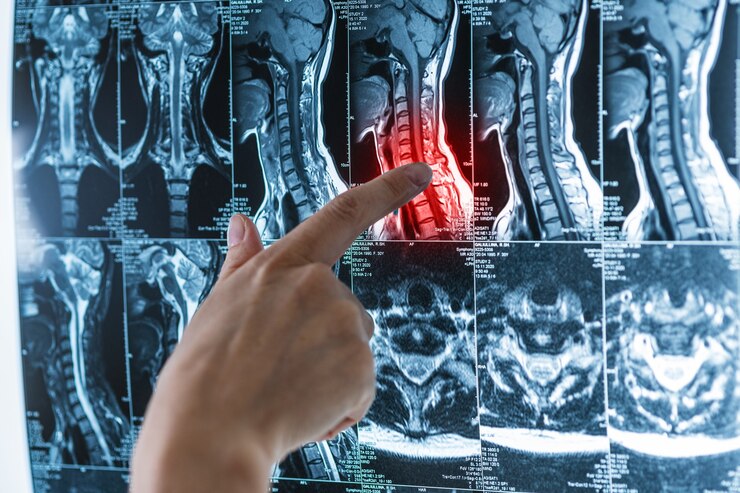Spinal fusion surgery treats issues with the spine’s tiny bones called vertebrae. The primary concept is to join two or more vertebrae so that they develop into a single, sturdy bone over time.
This procedure is done to stop painful motion or provide the spine with some stability. When your doctor can identify the cause of your pain, then spine surgery is advised. Read below to learn more about Spiral Fusion Surgery:
Why Spinal Fusion Surgery is Performed?
Spinal fusion permanently joins two or more of your vertebrae to increase stability, treat a deformity, or lessen pain. Spinal fusion may be advised by your doctor to treat:
- Spinal deformities: Correcting spinal abnormalities such as sideways curvature of the spine with spinal fusion (scoliosis).
- Weakness or instability in the spine: If there is irregular or excessive mobility between two vertebrae, your spine could become unstable. In such circumstances, spinal fusion can be used to regain spinal stability.
- Herniated disc: Using spinal fusion to support the spine may be necessary after a damaged (herniated) disc has been removed.
Uses of Spinal Fusion Surgery
Many spinal issues can be treated, or their symptoms relieved through spinal fusion. The treatment removes the mobility between two treated vertebrae. Despite the fact that it might reduce flexibility, this is effective in treating spinal disorders. These disorders include:
- tumors
- spinal stenosis
- herniated discs
- degenerative disc disease
- scoliosis
- kyphosis
- spondylolisthesis
- fractured vertebrae
- spinal weakness or instability due to severe arthritis, tumors, or infections
A discectomy might potentially be a part of a spinal fusion treatment. A discectomy involves removing a disc because it has been damaged. After the disc is removed, bone grafts are inserted into the vacant disc space to keep the distance between the bones at the proper level.
To increase long-term stability, your doctor will use the two vertebrae on either side of the disc to fuse or construct a bridge across the bone grafts.
How to Get Ready for the Surgery?
If you have not recently had a spinal X-ray, you might undergo certain blood tests the week before your surgery. The specifics of your surgery will be discussed with you by your medical team. If anything doesn’t make sense to you, ask the question immediately.
In the days leading up to your surgery, consider the following:
- Be aware of the arrival time surgery center.
- Obtain a list of medications you may or may not take in the days leading up to surgery. Aspirin and other anti-inflammatory medications are examples of drugs that may be dangerous. Never discontinue taking a medication without first getting your doctor’s approval.
- Find out whether you can consume any food or liquids before your treatment.
- Prepare your house for your arrival. You will require reachers, slip-on shoes, raised toilet seats, shower chairs, and other assistive devices.
Surgery Procedure
Spinal fusion can be done in one of the two ways given below:
- Anterior lumbar interbody fusion: The doctor goes inside your belly.
- Posterior fusion: Your doctor can enter from the back.
The muscles and tissues are shifted to the side once the incision is made so they can see your spine. The joints between damaged discs are removed.
The discs can be joined and prevented from moving using screws, rods, or bone fragments taken from another area of your body. Typically, the hip or pelvis is used for a bone graft that is taken from your own body.
Donor grafts are bones taken from another individual. Instead, some medical professionals inject bone morphogenetic protein into the spine. It promotes the growth of bones. The overall surgery procedure might last several hours.
Recovery After Surgery
After the Spiral Fusion treatment, you may need to stay in the hospital for recovery and observation. This usually depends on the treatment, but it generally takes three to four days. Initially, you will be absorbed by the reactions to the surgery and anesthesia.
Your discharge will depend on your overall improvement in your physical condition and your reaction to the operation procedure. During your hospital stay, you will receive the necessary pain medications. You will also be instructed about the ways you may need to move, as your flexibility may be limited.
You need to learn about the new technique to sit, walk and stand safely. For days it is possible that you may not take your normal solid foods. After leaving the hospital, you may need to wear braces to keep the spine in proper alignment.
Until the bones in your body get fused, you won’t be able to do normal activities. It may take six weeks or longer, and your doctor may recommend any physical rehabilitation to strengthen your back and also the ways to move safely.
Full recovery may take up to three to six weeks, but it depends on various factors like overall health, age and physical condition.
After Spinal Fusion Treatment
Depending on the extent and location of your surgery, you may experience some discomfort and pain, but it can be controlled by medications. If you exhibit the below-given signs, then contact your doctor:
- Wound drainage
- High fever
- Swelling and restlessness
It may take months for the bones that have been affected in your spine to fuse together. You may be recommended by the doctor to wear the brace for a time and keep the spine aligned correctly.
With the help of physical therapy, you will learn how to sit, stand, move and walk in a way that keeps your spine aligned properly.
Spine fusion Surgery in India
Spine fusion surgery in India can be a wise choice as the surgery can be too costly or may be unavailable in your country. India is a hub of high-quality medical centers and experienced doctors. Also, another advantage is that the spinal fusion surgery cost in India is more affordable than in most developed countries, and the cost varies depending on various factors.
Final thoughts
Spinal fusion treatment is an effective treatment for spinal conditions. The recovery may take months, and it can vary for different persons. Your comfort level and symptoms will improve as you gain confidence and strength in your movements.
Read Next: Brain Cancer Diagnostics




